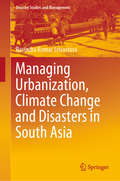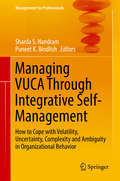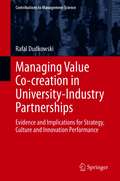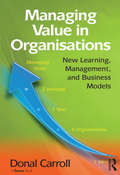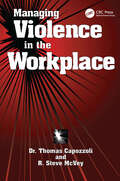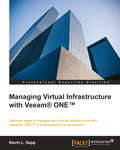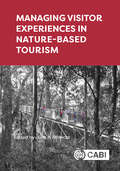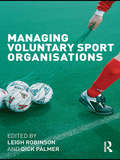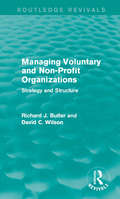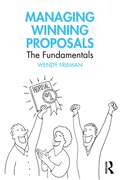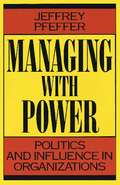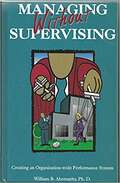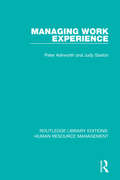- Table View
- List View
Managing Urbanization, Climate Change and Disasters in South Asia (Disaster Studies and Management)
by Ravindra Kumar SrivastavaThis book offers essential insights into potential catastrophic events that might befall upon the emerging urban landscape in South Asia, and which are due to hazards, risks and vulnerabilities inherent in the region’s geophysical location, as well as due to climate change and unplanned urbanization. It highlights major physio-graphic, demographic, geological and geophysical indicators that are responsible for changing the pattern and trend of urbanization in South Asia – a crucial issue in view of emerging threats of climate change, and changes in the demographic profile. The book addresses the disaster management scenario in South Asia, manifestations of climate change in the region and various urban setups under climate-change-induced risks. Further, it elaborates on the challenges of urbanization-based neo-risks and vulnerabilities, which manifest in the form of slum area growth, piling and littering of waste and filth, new health risks, groundwater contamination, air pollution, highly energy-dependent lifestyles, poverty, socio-economic tensions, etc. It also critically examines the institutional mechanisms for disaster risk reduction (DRR), climate change adaptation (CCA) and urban governance, and suggests appropriate changes in the governing structure to mitigate these risks. The book draws the attention of urban planners and policymakers to current shortcomings in the administrative and financial structures of local urban bodies. While outlining climate-associated risks and adaptation strategies in South Asia, it also suggests measures for integrating climate change and urban adaption with state's planning processes, and puts forward a risk alleviation platform to bring the risk managers working in different fields together, so that they make concerted efforts to achieve sustainable development. It offers valuable takeaways for researchers, urban planners, those working in industry, consultants, and policymakers.
Managing VUCA Through Integrative Self-Management
by Sharda S. Nandram Puneet K. BindlishIn this book, experts discuss whether volatility, uncertainty, complexity and ambiguity (VUCA) represent a challenge or a business opportunity. More intense debates on global climate change, increased turbulence in financial quarters, increased job insecurity and high levels of stress at the workplace are attracting attention in the context of organization behavior and entrepreneurship. Fear and confusion have become part and parcel of business, often undermining trust, cooperation and inspiration. As a response, a new way of organizing self-management has emerged. The book combines practical wisdom from East and West, to develop integrative self-management theory and practice; provides direction to support an integrative mind-set, integrative organization and integrative leadership; and presents VUCA as an opportunity and necessity for development and growth, rather than a threat.
Managing Value Co-creation in University-Industry Partnerships: Evidence and Implications for Strategy, Culture and Innovation Performance (Contributions to Management Science)
by Rafal DudkowskiThis book discusses how academic institutions can play a principal role in companies innovation strategy. The characteristics of University-Industry collaboration are strongly related to the social aspect of the activity of collaborating agents oriented towards a common object of work. To analyze this phenomenon, the author applies one of the concepts from the “Practice-Based Approach", namely the concept of the Activity Network to understand the collaboration process of R&D activities in a Nordic (Telia) and Swiss (Swisscom) Telecom Companies developing innovative products. The author focuses on four phases of University-Industry innovation partnership building: identification, selection, formation and navigation. The study shows the interactions between individuals, the contexts in which they act and explores ways in which collaborative value co-creation is managed. This pioneering research offers new theoretical insights and managerial implications on how these dynamics influence innovation in companies. It will thus be invaluable to international scholars, researchers of R&D and innovation as well as business managers.
Managing Value in Organisations: New Learning, Management, and Business Models
by Donal CarrollThe song of organisational change goes: 'Ready or not, here I come. You can’t hide...' But is change collapsonomics - everything - or have some things not changed? Managing Value in Organisations argues that traditional business thinking has produced low trust with high cost in increased disengagement: the 100 year old management model still accrues organisational debt, the business model privileges producers, and the learning model pretends individual learning produces collective learning. All are now barriers to development. Working with five organisations, Donal Carroll reinvents the management model to multiply trust, the business model for more complex customer value, and learning model for significant collective learning. He provides evidence that together, these get organisations to their next stage of development faster. In a climate of perceived increasing uncertainty and 'more for less' it invites organisations to move from default models and choose their models to 'live on purpose'. This applied business research has many new ideas: value creating research method, three new models, 'techniques' for organisations to self-assess and construct their next stage, as well as 'fecund argument, productive interference, organisational orphans' and 'facing down Facebook '. It invites readers on a risky narrative, testing one idea in five organisations, over one year through two journeys - the organisations’ and writer’s. A different business book, it seeks to capture the 'poetry and plumbing' excitement of management innovation. Managers at every level, coaches, consultants, business scholars, researchers, anyone seeking sustainable improvement, or who thinks the impossible can't be reached will find something here.
Managing Violence in the Workplace
by Thomas K. Capozzoli R. Steve McVeyManaging Violence in the Workplace is a prescription that contains many lists of "do's" and "don'ts" and "how to's" for proactive and reactive responses to workplace violence. The authors have analyzed numerous incidents in the workplace and constructed "how to" guidelines. Be prepared for managing workplace violence. Develop procedures to reduce the potential for violence, create contingency plans, fulfill your legal and moral obligation to employees and the public, reduce your company's liability, and provide a safer environment for all. Who can benefit from Managing Violence in the Workplace? Any organizational executive, risk manager, security, or human resource professional... anyone working to create a comprehensive, organizational program for response to potential and actual incidents of workplace violence.
Managing Virtual Infrastructure with Veeam® ONE™
by Kevin L. SappThis book is aimed at virtualization professionals who want to improve their skills in infrastructure monitoring and management. You need a good understanding of server virtualization and management of virtual environments.
Managing Visitor Attractions
by Brian Garrod Stephen WanhillVisitor attractions represent a complex sector of the tourism industry and are the catalytic focus for the development of tourism infrastructure and services. As this area grows, there are still many questions to be answered and issues to be understood – such as what visitor attractions actually are, what forces drive their development, who visits them and why, how they are funded, and what the numerous day-to-day challenges are in respect of their management andmarketing. The second edition of this successful text investigates these issues further and provides more solutions and suggestions for the present and future.Now in its 2nd edition, Managing Visitor Attractions: New Directions has been fully revised and updated to include new case studies on attractions in Singapore, seasonal variation,religion-based attractions, HRM issues and heritage tourism. It also includes five new chapterslooking at attraction success and failure, interpretation, school excursions, managing gardensand brand management.Divided into five parts, the book tackles the following core topics:• the role and nature of visitor attractions• the development of visitor attraction provision• the management of visitor attractions• the marketing of visitor attractions• future issues and trendsWith contributions from around the world, this is an essential text for undergraduate andpostgraduate students of visitor attraction management, written by subject specialists with awealth of experience in this field.
Managing Visitor Attractions: New Directions
by Alan FyallVisitor attractions represent a complex sector of the tourism industry and are the catalytic focus for the development of tourism infrastructure and services. The third edition of this successful text investigates these issues further and provides more solutions and suggestions for the present and future. Now in its third edition, Managing Visitor Attractions has been fully revised and updated to include new content on increased visitor numbers, new destinations and attractions, social media, overtourism, environmental awareness and the experience economy. The book includes case studies on topics such as overtourism at natural attraction sites, new attraction development in Egypt, dark tourism in Latin America, dementia-friendly attractions, and manging sporting venues as attractions. New chapters include the role of the visitor attraction manager, managing safety and risk, themed attractions and storytelling, and digital marketing, among many others. With contributions from around the world, this is an essential text for undergraduate and postgraduate students of visitor attraction management, written by subject specialists with a wealth of experience in this field.
Managing Visitor Experiences in Nature-based Tourism
by Haywantee Ramkissoon Brent Lovelock Mary E. Allen Robert C. Burns Azizul Hassan Peter Fredman Ali Thompson Mick Abbott Karl Agius George Ariya Rocío Blanco-Gregory Cameron Boyle Kadir Çakar Eugenio Conti Fernando Enseñat-Soberanis Sonia Ferrari Stuart Hayes Nicolaia Iaffaldano Woody Lee Tiago Lopes Andrés Ried Luci Lusine Margaryan Johnathan Mondragón-Mejía Ana Goytia Prat Francisco Silva Jeffrey C. Skibins Ismail UzutThis book focuses on the experiences of tourists visiting nature-based destinations, exploring current knowledge and providing insights into conceptual issues through the use of empirical evidence from five continents. Presented as three topics, the contents discuss tourism and nature-based experiences by looking at the role and relevance of nature and the uniqueness of such experiences. The book identifies visitor management challenges and provides explanations for the solutions reached. The final section takes a more overarching destination management perspective that transcends the tourism product or business level and focuses on destination and generic issues like indicators or marketing implications. The book also includes research-based case studies which contribute to an overall understanding of the core issues involved in managing visitor experiences in nature-based tourism.
Managing Voluntary Sport Organizations
by Leigh RobinsonContemporary sport could not function without the involvement of voluntary organizations, from local grass-roots clubs to international agencies such as the International Olympic Committee. Management of this sector continues to undergo profound change, largely in response to the challenges of professionalization and increasing expectations in terms of transparency, accountability and ethical behaviour. This book fills a significant gap in the literature on sport management by setting out the principles and practices necessary for effective management of voluntary sport organizations around the world. In addition to applying and adapting established management strategies and techniques to voluntary sport organizations, this book is the first to fully relate mainstream organizational theory to this important sector of sport management. With contributions from an international team of researchers and management practitioners, the book explores key functional areas such as: governance strategy and planning human resources finance managing change marketing event management risk management. Each chapter discusses best practice and includes case study material, self test questions and guides to further reading. As the only book to outline a professional, theoretically informed and practically focused curriculum for voluntary sport management, this book is essential reading for all students of sport management and all managers working in or alongside the voluntary sector.
Managing Voluntary and Non-Profit Organizations: Strategy and Structure (Routledge Revivals)
by David C. Wilson Richard ButlerDrawing on detailed empirical data and a range of case studies, Managing Voluntary and Non-Profit Organizations, first published in 1990, demonstrates how voluntary organizations formulate strategies for securing funds, providing services, and dealing with other non-profit bodies, public agencies, and the private sector. The central theme is organizational change and how managers have responded, strategically and structurally, to changes to their environment. Using original data, and writing from the broad perspectives of current organization theory, the authors increase our understanding of strategies, structures and designs currently in use in the voluntary sector. Their authoritative text will make essential reading for practising managers in non-profit organizations and for an international audience of academics and students of management, organization theory, and strategy.
Managing Volunteers in Tourism
by Karen Smith Kirsten HolmesRecent years have seen an explosion in research on tourism volunteering. Volunteers are an essential part of tourism, whether they are volunteering in their local museum, at a sporting mega-event, as an airport ambassador, or travelling the global as a volunteer tourist. Managing Volunteers in Tourism reviews the latest research to highlight the key management issues and relate them to the tourism volunteering context. It includes previously under-researched forms of tourism volunteering such as meet-and-greeters, surf life-savers, conservation, festival, and information centre volunteers and volunTourists. The book develops through three distinct sections, the first of which begins by introducing the concept of volunteering and considering the variety of volunteer forms and settings within tourism. The next part picks up the organisational approach and examines volunteer program design and planning, volunteer motivation, recruitment and selection, training and development, reward and retention, and diversity management. The final part consists of ten case studies from leading international researchers and practitioners identifying best practice and key management challenges. Real-life examples and case studies throughout this book provide an in-depth examination of the challenges facing those managing tourism volunteers, making this book indispensible for current and future managers in the tourism industry.
Managing Water Resources in a Time of Global Change: Contributions from the Rosenberg International Forum on Water Policy (Contributions from the Rosenberg International Forum on Water Policy)
by Alberto Garrido Ariel DinarGlobal change possesses serious challenges for water managers and scientists. In mountain areas, where water supplies for half of the world population originate, climate and hydrologic models are still subject to considerable uncertainty. And yet, critical decisions have to be taken to ensure adequate and safe water supplies to billions of people, millions of farmers and industries, without further deteriorating rivers and water bodies. While global warming is known to cause glaciers’ retreat and reduced snow packs around the world, it is not clear that mountain discharge will be lower. What is widely recognised is that water management must be adapted to accommodate significant regime changes. However, this inevitably involves managing transboundary rivers, adding further complexity to putting principles in practice. This book takes global warming and the importance of mountain areas in world water resources as the starting point. First, it provides detailed reviews of the processes going on in several rivers systems and world regions in Europe (Rhône and Ebro), North America (Canadian Rockies, Western US and Mexico), the Middle East (Jordan), Africa (Tunisia, Kenya and South Africa). These contexts provide case studies and examples that show the difficulties and potential for adaptation to global change. Land-use, economics, numerous modeling approaches are some of the cross-cutting issues covered in the chapters. The volume also includes the views of water practitioners, with two chapters authored by members of the US-Canada International Joint Commission, an industrialist from Western Canada and an environmental leader in Spain. By combining a rich set of contexts and approaches, the volume succeeds in offering a view of the global challenges faced by water agencies, international donors and researchers around the world. A case is made in some chapters to seek adaptive strategies rather than trying to reduce or control resources variability. This requires factoring in land-use, social and economic aspects, especially in developing countries. Another conclusion is that complex problems can and must be posed and negotiated with the help of models, mapping techniques and science-based facts. However complex these may be, there are ways to translate them to easily interpretable and visualisations of alternative scenarios and courses of action. This book provides numerous examples of the potential of such approaches to draft environmental programmes solve transboundary disputes and reduce the economic consequences of droughts and climate instability.
Managing Web Projects (ESI International Project Management Series)
by Edward B. FarkasGetting Web projects done right and delivered on time is all about efficiency. Putting the information you need and tools you can rely on at your ready disposal-Managing Web Projects-is a complete guide for project managers in the Internetworking industry. Whether you are a Web developer or an Internet Service Provider, whether your project is a qu
Managing Winning Proposals: The Fundamentals
by Wendy FriemanPreparing a proposal for a contract or a grant can be an overwhelming and extraordinarily complex process, but regardless of the proposal type or sector, certain truths always pertain. This book walks the proposal manager through the steps that are essential and common to every single proposal and ensure a foundation for winning. Many proposal management books are of little use, particularly to a first‑time proposal manager, owing to their broad scope and unrealistic assumptions about resources, including time, expertise and information. This book provides actionable, concrete steps for the activities that underpin all successful proposals, providing a step‑by‑step description of how to make a proposal compliant and compelling. The premise of this book, based on the author’s hands‑on experience in multiple proposal roles for over three decades, is that proposals do not go off the rails owing to an inability to implement advanced techniques and complicated processes. They fail because of inattention to fundamental activities. Other business books cover some of these fundamental activities. However, proposals differ because of their tight constraints: deadlines, the need for perfect compliance with detailed instructions, fierce competition for limited funds, the consequences of not winning and the stress that inevitably accompanies the process. Focusing solely on the preparation of the written proposal document and not on sales, negotiation, marketing, or customer interaction, this book dives into the details of the tasks facing the person actually accountable and responsible for preparation and delivery of the proposal. Proposal managers of all levels, from first‑timers to seasoned pros looking to polish their skills, as well as those who participate in the proposal process but are not intimately familiar with it – artists, technical writers, project managers, accountants and others – will benefit from the processes and tools described in this book.
Managing With Power
by Jeffrey PfefferAlthough much as been written about how to make better decisions, a decision by itself changes nothing. The big problem facing managers and their organizations today is one of implementation--how to get things done in a timely and effective way. Problems of implementation are really issues of how to influence behavior, change the course of events, overcome resistance, and get people to do things they would not otherwise do. In a word, power. Managing With Power provides an in-depth look at the role of power and influence in organizations. Pfeffer shows convincingly that its effective use is an essential component of strong leadership. With vivid examples, he makes a compelling case for the necessity of power in mobilizing the political support and resources to get things done in any organization. He provides an intriguing look at the personal attributes-such as flexibility, stamina, and a high tolerance for conflict-and the structural factors-such as control of resources, access to information, and formal authority-that can help managers advance organizational goals and achieve individual success.
Managing Without Managers
by Ricardo SemlerSemco S/A is a manufacturing company in Brazil where workers make corporate decisions, set their own hours, and have access to monthly financial figures. The company's management philosophy is antihierarchical and perhaps unorthodox, but its profits are handsome. The company operates on the basis of three key principles: work force democracy, profit sharing, and free access to information. Democracy lets employees set their own working conditions; profit sharing rewards them for doing well; information tells them how they are doing.
Managing Without Power
by R Meredith BelbinMeredith Belbin, best known for his work on teams, now considers the way in which continuing evolution has produced distinct patterns of behaviour for men and women. Examination of the key stages in the history of homo sapiens reveals* how very early human society was regulated not through power but by organic balance, so allowing women to play a vital role in the community* why women lost their hold over men as more populous and structured societies became dominated by aggressive warriors seeking territorial expansion* how natural selection within competing empires favoured the survival of able professionals and compliant slaves, so diversifying the behavioural roles to which humans were genetically disposed* how, in the present era, power has lost its biological utility as human evolution slowed, and technological evolution favoured the emancipation of women with its premium on communication skills*how in this changing scenario, as women have recovered their status and influence, social progress has brought in its wake a new set of cross-gender problems.Penetrating, original and provocative this book offers suggestions on how men and women can come to terms with their genetic heritage, so restoring much needed balance to business organizations and to the community at large.
Managing Without Supervising: Creating an Organization-Wide Performance System
by William B. AbernathyCompanies are challenged to keep all aspects of their organizations moving forward, in good times and in bad, especially with the recurring cycle of economic discontent. But how an organization manages its employee costs, while keeping employees vested in the success of the company, can be the difference between success and failure. <p><p> In this book, the author guides readers through both the development and long-term management of an effective performance system and outlines how to create employee stakeholders who are focused on the company s success. This book illustrates how to measure all types of performances, how to organize measures into balanced scorecards, and how to link incentives to performance improvement through Profit-Indexed Performance Pay<sup>TM</sup>. Pay for Profit also provides readers with invaluable information on how to manage and sustain a performance system including techniques for validating measures and incentive payouts, as well as performance analysis and improvement strategies.
Managing Women: Disciplining Labor in Modern Japan
by Elyssa FaisonManaging Women focuses on Japan's interwar textile industry, examining how factory managers, social reformers, and the state created visions of a specifically Japanese femininity. Faison finds that female factory workers were constructed as "women" rather than as "workers" and that this womanly ideal was used to develop labor-management practices, inculcate moral and civic values, and develop a strategy for containing union activities and strikes.
Managing Work Experience (Routledge Library Editions: Human Resource Management Ser.)
by Peter Ashworth Judy SaxtonThis book, first published in 1992, sets out the belief that the placement element of courses should be designed from the start as a genuine educational experience. The learner most not merely live through experiences which are supposed to lead to personal and professional development, but must reflect on experiences in a way which is planned to
Managing Work in the Digital Economy: Challenges, Strategies and Practices for the Next Decade (Future of Business and Finance)
by Klaus North Stefan Güldenberg Ekkehard ErnstThis book provides well-founded insights and guidance to (self-)manage work in a globalized and digitalized knowledge economy with a perspective of the year 2030. International researchers and practitioners draw a picture of how, when, and where we will work most probably in 10 years. Many cases and examples make this work a compendium for learning and for implementing new leadership and management practices. The book assists managers, knowledge workers, human resource professionals, consultants, trainers, coaches in business, public administration, and non-profit organizations to shape the future of work. Drawing on the authors’ more than twenty years of research, teaching, and consulting experience, this is one of the first professional guidebooks to analyze and discuss strategies for digital and disruptive changes at the workplace.
Managing Work-Life Balance in Construction
by Helen Lingard Valerie FrancisWork in the construction industry is particularly tough. It demands excessively long hours and frequent weekend work. Other characteristics are particularly marked, such as re-location, job insecurity and distinctive behavioural patterns, which negatively affect employees’ personal lives further. Work–life balance has emerged as one of the most pressing management issues in the 21st century. For construction managers dealing with traditional models of work and rigid work schedules, the issue may be especially difficult to manage, and yet the work–life balance is now recognised as an issue of strategic importance to the construction industry. It is critical to the construction industry’s continued ability to attract and retain a talented workforce, and it is also inextricably linked to organizational effectiveness and employees’ well-being. This book presents the argument for the management of work–life balance in the construction industry. It maps the changes to the workforce demographic profile and the changing expectations relating to work and personal life that occurred during the second half of the 20th century. Legal imperatives for managing work–life balance are set out. It also presents work–life balance theory and discusses the practical implications of research, along with extensive empirical data collected from the industry. Lastly, practical advice is provided about what construction organizations can and should do to manage work–life balance. This provides a unique guide to a key issue.
Managing Workers' Compensation: A Guide to Injury Reduction and Effective Claim Management (Occupational Safety & Health Guide Series)
by Keith Wertz James J. BryantLaying out management and safety procedures that reduce injuries and the aggravation that follows, this book covers hiring, training, and managing employees with injury avoidance in mind. The authors provide a blueprint for dealing with injured employees and their families, and for determining the correct time for the employee to return to work. The book discusses the all-important issues of fraud, modified duty, substance abuse testing, and accident investigations. It also provides guidance for managing safety efforts in a manner that controls workers' compensation cost. The book shows readers how they can impact - favorably - the amount their organization pays in premiums.
Managing Workplace Bullying
by Aryanne OadeThis is a comprehensive, practical and engaging book designed to help readers to recognise bullying behaviour at work and identify and select inter-personal strategies for handling bullying behaviour.
